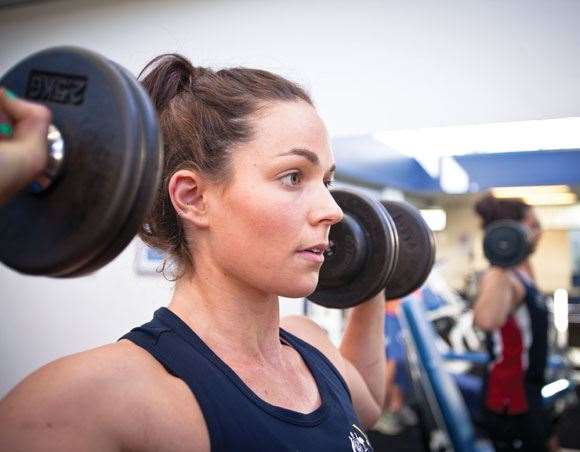Water polo is a sport made to measure for the Australian psyche: it’s rough, it’s tumble, and it’s played in water.
 Photos By, Shelby Hayden Craig
Photos By, Shelby Hayden CraigDefending the realm
“As a centre back, I mark the opposition centre forward – typically the biggest player in a team. There’s a centre forward in the Italian team called Elisa Cassanova and she is absolutely massive; 115kg at least. Believe me, marking a girl like her is hard work. When we’re playing Italy and I’m on Cassanova, that’s when team work really comes into play. We have to play zone defence – usually three-back – so I’m not just marking her one-on-one.
“I also have to make sure I work hard in attack, so she has to work hard up and down the pool. As soon as it’s our ball, I have to take off and Cassanova has to chase me up the pool; by the time it’s their ball, she has to sprint back down the pool in attack. Hopefully that tires her out. Because she’s such a big girl, her downfall is her swimming. But I definitely have to make sure I don’t get physically involved with her. When I’m marking her, I have to stay off her and swim around her, rather than wrestle with her, because there’s no way I can muscle up to her. That’s a big part of defence: choosing the time to muscle up to someone and choosing the time to use your speed rather than your strength.”
Firing line
“Even though I’m a defender, shooting’s a big part of my game. We all have to defend and we all have to attack. Just because I’m a centre back, it doesn’t mean I play centre back every defence ‒ quite often I’m one of the main attackers as well.
“With shooting technique, it’s important to get your whole body into the shot, not just your arms. Basically that means you have to get as high out of the water as possible by doing a hard eggbeater kick. There are two reasons for this. Firstly, it allows you to get over your defender. Secondly, the more of your body that’s out of the water, the less restriction you’re going to face in making the shot, so it allows you to shoot higher and faster.
“Once you’re up and out of the water, it’s important to have your left shoulder pointing to where you want to shoot. Then it’s all about getting the sequence right: your left shoulder goes first, then your right shoulder, then your arm. Your wrist should always be the last thing to flick. It’s all a big rotation. But shooting’s a very personal thing ‒ a lot of the girls have very different techniques. I’m more of a round-arm shooter, but a lot of the girls shoot straight up and down, over the top of their shoulder.”
Skill session
“In the water we do so much ball work. Passing drills, blocking drills, moving in the water with a ball, using our legs to propel us ... Again, with all these ball skills, it’s really important to get your legs working well, so when you’re throwing or catching the ball you’re as high in the water as possible. We do a lot of leg work drills where we’ve got the ball in our hand at the same time. Our coach also has a rule that we have to carry a ball at all of our sessions. While we’re at the pool we’re playing with the ball, fiddling with it, lifting our skills even though we’re not really thinking about it.
“It’s only in the last two years that we’ve started doing a lot of our ball work out of the pool. In fact, we’ve recently had an AIS basketball coach come down and show us some of their drills, so we can incorporate them into our ball work sessions. It’s been great practising a few moves that aren’t normally seen in water polo. We’ve incorporated some basketball picks and spins into our game, using some of the skills ... some of the different movements that basketballers use to get free in their game. In water polo you’ve typically got the centre forward who sits in front of the goal, but this coach explained that if the centre forward can come out and act as a blocker, then it allows the drivers to spin around her. Basically, it’s about having more attackers moving towards the goal. It’s really interesting getting another sport’s input. After all, water polo’s essentially a combination of basketball, soccer and European handball, but it’s in the water.”
Pool fit
“We do two or three swim sets a week, of about three and a half km s. They’re pure swim sets ‒ we never just swim three km s straight. We might have one session focused more on sprints, another focused on endurance.
“We also do aerobic power sessions ‒ these are the sessions we absolutely dread! Basically, these normally involve four three-minute blocks, with 30 seconds’ break in between each block. Each block is then filled with water polo-specific drills; so we might wrestle for ten seconds, then the coach will blow a whistle and we’ll have to sprint up the pool, then do ten water jumps, then sprint back and start wrestling again. It’s always a combination of getting physical and swimming. We also do sessions that combine swimming and ‘underwaters’. So we’ll push off the wall and go as far as we can underwater, then, when we surface, we have to sprint back to the wall. Basically, these sessions are all about building lung capacity. They also kill us!”
Related Articles

Bronzed finish for Stingers at World Championships













